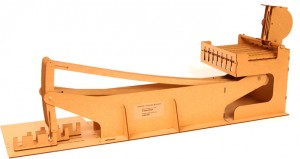
The Computer of Fowler
The first fully programmable computer was Designed by Charles Babbage in 1837. Babbage failed to get enough money to Build his Analytical Engine. It was never build.
The failure of Charles Babbage delayed the creation of the current computer for about a 100 years.
Nobody knows that Thomas Fowler Designed and Implemented a completely different and simple wooden computer in 1840. The big difference between Babbage and Fowler was the Number System. Babbage used Base 10. Fowler used the Balanced Ternary Number System.
About the Ternary Number Systems
The balanced ternary number system is created by balancing Ternary (Base 3) Numbers around the Centre of the Number Line, 0. A balanced ternary number is a combination of negative and positive ternary numbers.
The balanced ternary number system is a very special Number System because all the basic mathematical operations, addition, subtracting, multiplication and division are accomplished by the application of very simple operations based on very special symmetries.
Symmetries are the foundation of Simplicity, Beauty and Elegance. The Engine of Fowler was a very simple and beautiful machine made out of wood.
In 1958 a Ternary Computer, the Setun, was build at the Moscow State University. It was never used.
About Number Systems
When you want to represent a number you can start with base 1. The number 13 is represented by thirteen “1′s, “1111111111111″.
Of course you are free to use other symbols to represent the number “1″. When you want to represent 13 goats you could use 13 goat-like symbols. When you want to represent many goats the sequence of goat-like symbols becomes very long.
The next step is to group the goat-like numbers. You could group them in binary groups (11 11 11 11 11 11 1), ternary groups (111 111 111 111 1) or in every other group you want.
In every case you have to assign new symbols like “1″ → “-”, “11″→ “=” and “111″ → “≡”. The number 13 becomes “≡ ≡ ≡ ≡ -”.
When you have defined a grouping method you can repeat this method. The only thing you need is a new symbol “x” to represent repetition, a symbol that represents addition “+”, a rule how to read the sequence (left to right, right to left) and symbols (“(,”)”) that show what has to be combined. ≡ x (≡) + ≡ + – now means 3X3 + 3 + 1 = 13 (and not 3x(3+1 +1) = 21).
If you want to use a high base number you need many symbols to represent the numbers of the group. If you use a low base number you need many symbols to represent the repetition. An obvious strategy is to minimize the product of these two quantities. The result of this calculation is the number 3 (or better the number e)!
About Ternary Memory Systems
The number 3 is the most efficient way to represent numbers. There is much more to say about the properties of the number 3. One of these properties can be used in Databases and Storage systems.
A Balanced Ternary Storage system can be easily expanded because you can always add a new entrance in the middle. The Balanced Ternary Storage System (represented by the Arabic Mystical Lote Tree) is one of the simplest and efficient storing methods of data.
What is the reason behind this Blog?

The Universe is a highly complicated Knot
I am writing this blog because I have spent a lot of time to research the Scientific and Spiritual Trinity. The mathematical and the spiritual theory about the Trinity have a lot in common.
The Trinity or the Ternary Number System is the most efficient, most effective and most beautiful (in terms of symmetries) way to Represent, Calculate and Store Numbers. The Trinity is therefore the most effective Way to Represent the Fractal Expansion of the Dynamic Whole.
What happened?
The beginning of the Universe is a transformation of the Void (Ø) into the Nothing (0).
In the next step, the Egg of the 0 became the One (1) that splitted into the Duality (2) to become Aware of Itself.
In this case the first sequence of creation becomes Ø,0,1,2.
When we rewrite this sentence in balanced ternary language we read something else. In this case the beginning of the Universe is an expansion of the Void (0) into a negative (-1) and a positive part (1). The first sequence of creation becomes Ø (zero members of the set), (-1,0,1)(3 members of the set).
In the ternary balanced language the next expansion of the Universe is created by expanding the negative and positive part of the Universe in the Middle. A new expansion is created by adding the same structure in the Middle of the Middle of the Middle.
|
1 |
Ø |
||||||
|
2 |
-1 |
0 |
1 |
||||
|
-1 |
0 |
1 |
-1 |
0 |
1 |
||
|
3 |
-2 |
-1 |
-0 |
0 |
+0 |
1 |
2 |
This expansion moves on until the system has replicated itself. At that time the expansion moves faster and faster and faster. The Self-Referencing System of the Universe, the “Divine Fractal“, is unfolding itself at an ever increasing (logaritmic) speed in a spiraling spiral pattern creating many more (negative and positive) Numbers.
At a certain point the Negative and Positive numbers are Voided in the Zero and the Universe starts to expand again.
The unfolding creates many universes and one of these Universes is our own Universe. All the time the center, the 0, the Void, stayed at the middle.
At this moment the lowest level, our level, is almost finished and a new Evolution, a Jump to a new Level, has to start. This Jump will be a Jump out of the middle, the Heart Chakra.
Is this Explanation too Simple?
This explanation is much too simple because the whole creation process is now projected into one dimension, a Line, and we are looking at the third step of the Fourty-Two (3×13 +4) Steps that have happened until now.
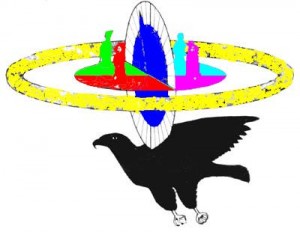
The basic structure of the Material Universe, the World Clock of Wolfgang Pauli, carried by the Demiurg, The Trickster.
Every split of the universe creates a new dimension. The splitted parts of the Universe, the balanced ternary trees, are Rotating Structures that contain Rotating Structures.
They look like the image of the rotating World Clock of Wolfgang Pauli that is carried by the Raven (the Trickster, the Demiurg), the Four Beasts in the Vision of Ezekiel and the Sri Yantra.
The other complication is that the Universe is creating its own Space and is therefore closed in itself. There is no Outside of the Universe. We are not living Inside an expanding Balloon but are travelling the Inside Surface.
When the Universe has expanded for a very long time the many dimensions are still there but they show themselves in very complicated Topological Structures like (Celtic) Knots, connected Moebius Rings, the Symbol of Infinity and the Klein Bottle, the Basic Structure behind Alchemy.
It is simply impossible to show and understand the current complexity. The only thing that is very helpful is to realize that the structure behind the Universe is a Fractal.
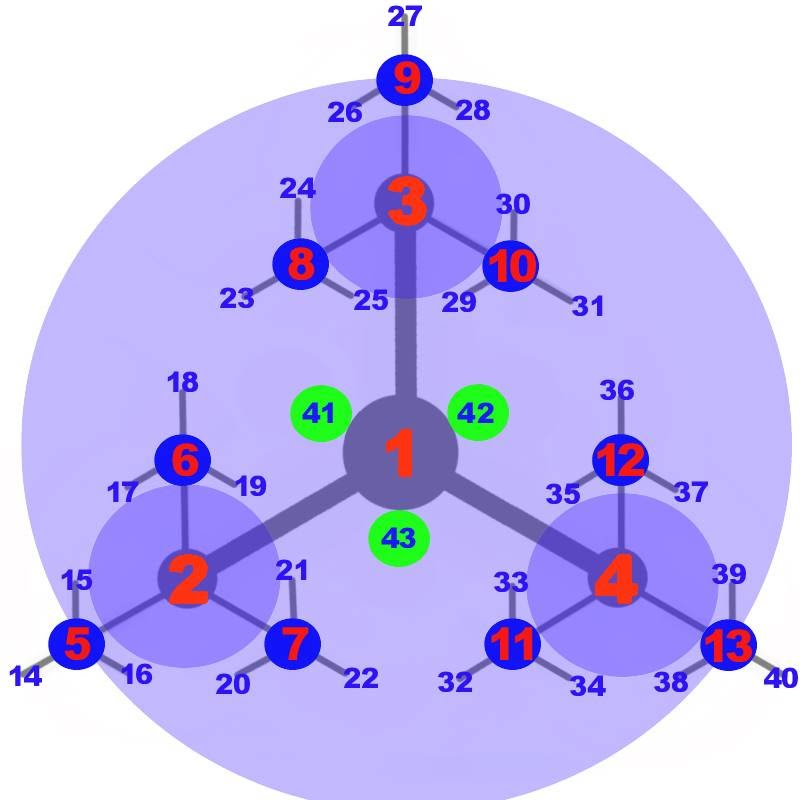
The Balanced Ternary Tree of 43.
This means that that at every level the same structure repeats itself. When you know everything there is to know about One Level you know every thing there is to know about Every Level.
If You understand the Human Being, You understand the Universe. This principle was called by the Ancient Scientists, “So Above, So Below” and “As Within, So Without”.
The Balanced Ternary Number System or the Trinity that contains the Trinity can be used to explain Your Self.
It can be used to explain the “strange” behavior of the Brain Trinity, a combination of a Whole, the Body, A Left and a Right Brain. The “Trinity Pattern” repeats itself in every part of your body.
The pattern of Seven (The Trinity in the Trinity) shows itself as the Seven Chakra’s. The next step, the Thirteen (3×4 +1 = 13), shows itself in the Twelve Signs of the Zodiac (+ the Center, the Pole Star), the Twelve Apostles (+ Jesus) and the Twelve Knight of Arthur (+Arthur).
The Expansion of this pattern on a much deeper level also generates the Acupuncture Points (Nadi’s) in Your Body.
Why is Science not Aware of this?
The main reason can be found in the story of Thomas Fowler. He invented a Very Simple computer system but he was beaten by the Complicated system of Charles Babbage.
Babbage used the 10 base to define his Engine and he needed lots of money to create this very complicated system. He never finished his analytical engine but many years later IBM almost copied his design when they developed the IBM 360. They were, like Microsoft, experts in Marketing. They sold what the Customer wanted to buy and never took time to think about the Essence.
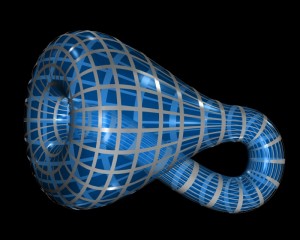
The Klein Bottle, The Universe Closed in Itself, the Basic Structure behind Alchemy.
Thomas Fowler was a very simple man. He tried to do his best and was never aware of the power structures that controlled science and the market at that time. He wanted to help people but helping people is the stupidest thing you can do in a capitalistic system.
When an infrastructure is chosen it is almost impossible to change the infrastructure because everything that is build on top of this infrastructure becomes obsolete when the foundation is wrong. We will never be able to introduce a ternary computer infrastructure unless something happens that breaks the upper layer. Some people think this time is near.
Simplicity, Elegance, Beauty and Efficiency are not the main object of Capitalism. The main object of Capitalism is Making Profit.
What is the best Way to acquire Scientific Knowledge?
Thomas Fowler was not educated in the science of his time. He just invented the mathematics he needed. When he was educated in the science of his time he could have invented the same machine but it is much more plausible that he would have invented another Analytical Engine.
Thomas Fowler used his own judgment and his own talent to create something he thought was useful to support his own banking system (he also created a Bank!).
The Balanced Ternary Database of the Universe was called the Akasha. According to the Ancient Scientists of India every memory of the past and the future is stored in the Universe. They believed we are part of a Super Mind and this Mind knows everything that has happened or will happen.
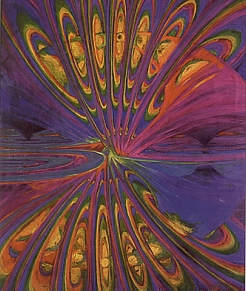
The Vortex, a Painting of Walter Russell
Some people are suddenly connected to this Super Mind. They are Enlightened and find a solution for a very complicated problem in a Dream or a Trance State.
One of the most important scientists of our time, Wolfgang Pauli, found everything he wanted to know in the Akasha. There are many others like Walter Russell (The Secret of Light) and Malcolm McEwen (The Lesson of the Light).
Strangely enough all of them receive or have received the same information.
What is going to happen?
The expansion of our Universe is getting into a critical state. This state is visible in all the fractal levels of our Universe.
It is visible in the Weather System, The Ecological System, The Economic System and the Cultural System. All of them are changing.
It is also visible in many Human Beings who experience the intervention of the Super-Mind in their Lives.
The big transformation must be visible in the Seven, until now not-connected universes. The other universes are currently shielded behind a Veil but this veil is slowly lifting. The movement of the Veil could explain the huge increase of Strange Encounters with Extraterrestials.
Our universe has been expanding and but very soon it will or may appear to stop. Our Universe may even begin to appear to shrink but it is not because it is reversing, heading towards some kind of big crunch but because it is folding, connecting to Itself, the Super Mind.
In the first stages of the Universe the Light was created but now we are entering a new phase where the consciousness of the Super Mind, is opening up to all the inhabitants of all the Seven Universes.
The opening of the Super Mind to all the Souls of the Universe has been named with many names in many religions all over the World (Ascension, the Golden Age, Point Omega, The Last Judgment, the Fifth World, The End of Time).
It is not clear what the connection with the Super Mind will accomplish. Many inspired scientists and prophets have tried to describe and explain this state.
One thing is sure it will be very different from the current situation where we are all isolated souls existing in many disconnected time-lines in many disconnected universes.
LINKS
Why the number e is the best base for a modular system
Many Properties of Ternary Numbers
Many Properties of the Balance Ternary Number
Why the Balanced Ternary Numbers are Special
A Visualization of the Trinity Pattern with the Platonic Solids
The 4 Videos of Malcolm McEwen below contain a Visualization of the Trinity Pattern
McEwen, Video, The Lesson of the Light, Nr 1
McEwen, The Lesson of the Light, Video, Nr 2
McEwen, The Lesson of the Light, Video, Nr 3
McEwen, The Lesson of the Light,Video, Nr 4
McEwen, Realizing the Super Mind (PDF) (Downloading takes time!)
About Plato and the New Harmony
About the Expansion of the Whole
